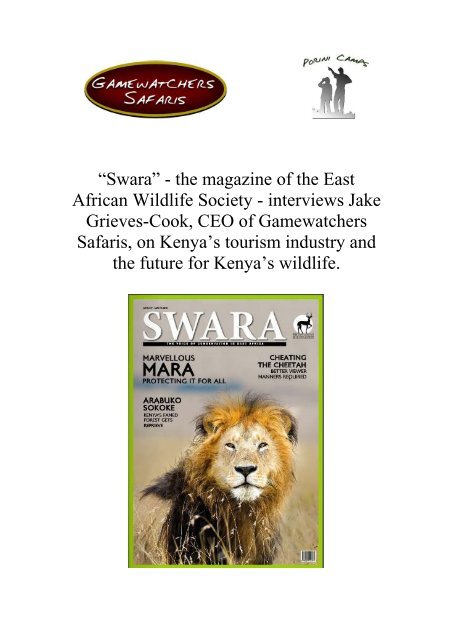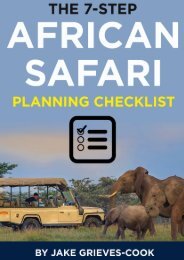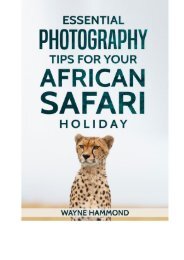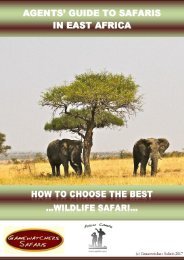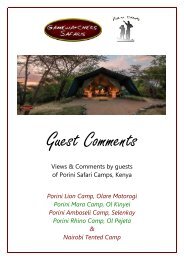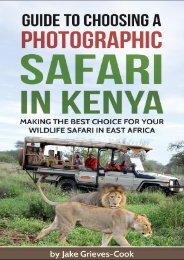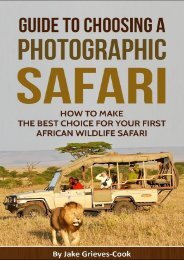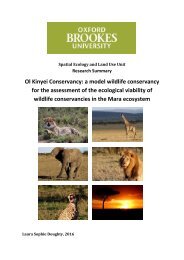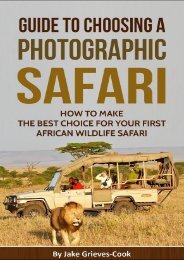Swara Magazine Feature
Andy Hills from “Swara” (the magazine of the East African Wildlife Society) interviews Jake Grieves-Cook, CEO of Gamewatchers Safaris, on Kenya’s tourism industry and the future for Kenya’s wildlife.
Andy Hills from “Swara” (the magazine of the East African Wildlife Society) interviews Jake Grieves-Cook, CEO of Gamewatchers Safaris, on Kenya’s tourism industry and the future for Kenya’s wildlife.
Create successful ePaper yourself
Turn your PDF publications into a flip-book with our unique Google optimized e-Paper software.
“<strong>Swara</strong>” - the magazine of the East<br />
African Wildlife Society - interviews Jake<br />
Grieves-Cook, CEO of Gamewatchers<br />
Safaris, on Kenya’s tourism industry and<br />
the future for Kenya’s wildlife.
CONSERVATION<br />
The name of Jake Grieves-Cook has been synonymous with tourism<br />
in Kenya for four decades, especially in the Maasai Mara. A former<br />
chairman of the Kenya Tourist Board and Council member of EAWLS,<br />
he is now CEO of Gamewatchers, which operates prize-winning lowimpact<br />
camps in the Mara along the sustainable, community-centred<br />
lines he so passionately espouses. SWARA will be visiting one and<br />
reporting back in the 2015 - 02 issue.<br />
People say the balance<br />
between conservation and<br />
tourism in the Mara has<br />
reached tipping point,<br />
crisis point or already gone into<br />
critical decline.What’s your view?<br />
The Mara was where I started<br />
my career in tourism over<br />
40 years ago, based at what<br />
was then the only tourist lodge in<br />
the Reserve, so I have seen some big<br />
changes over the years! During the<br />
past two decades there has been a<br />
huge increase in the number of tourist<br />
accommodation facilities, with new<br />
lodges and camps mushrooming both<br />
inside the Mara Reserve and outside on<br />
the periphery in places like Talek or as<br />
ribbon developments along the Mara<br />
River. There have been complaints<br />
that sometimes new camps and lodges<br />
have been built on sites that were the<br />
home territory of various wild animal<br />
species but the main adverse impact of<br />
all this new development has been to<br />
greatly increase the number of tourist<br />
vehicles inside the Reserve during the<br />
July to October peak season. This is<br />
when masses of minibuses and 4x4s<br />
congregate along the Mara River in the<br />
hope of seeing a “crossing”. There are<br />
now just far too many vehicles in the<br />
Reserve during the migration season<br />
with the tourism density often so high<br />
that it spoils the visitor experience and<br />
can actually obstruct the animals and<br />
prevent them from crossing at their<br />
favourite spots. Another problem has<br />
been caused by the greatly increased<br />
human settlement in recent years near<br />
the Reserve and the accompanying<br />
increase in livestock numbers. This puts<br />
pressure on the Reserve with frequent<br />
livestock incursions as herders look<br />
for grazing for their cattle after much<br />
of the outer Mara has now become<br />
over-grazed, or privately owned and<br />
fenced off by the owners following subdivision,<br />
or cultivated by wheat farmers.<br />
Livestock grazing on the savannah<br />
plains can actually have a positive effect<br />
for wildlife in providing short grass and<br />
stimulating the new growth favoured<br />
by some animals such as gazelles or<br />
warthogs. Also areas which have been<br />
grazed down are preferred by many<br />
herbivores which deliberately avoid the<br />
long grass in which predators such as<br />
lions could be hiding. Unfortunately,<br />
nowadays the amount of grazing by<br />
livestock is often so excessive during the<br />
dry season that nothing remains for the<br />
wildlife and this causes real problems.<br />
However one positive development,<br />
which addresses both the issue of<br />
tourism density in the Mara and grazing<br />
for livestock, has been the establishment<br />
in the last ten years of new wildlife<br />
conservancies on community-owned<br />
land adjacent to the Reserve at Ol<br />
Kinyei, Naboisho, Olare Motorogi and<br />
Mara North Conservancies. These<br />
conservancies have created a buffer<br />
zone taking the pressure off the Reserve,<br />
increasing the area of protected habitat<br />
for wildlife, and providing a greatly<br />
improved wildlife viewing experience<br />
for tourists while at the same time<br />
generating incomes and livelihoods for<br />
the hundreds of Maasai landowners<br />
whose plots have been leased to form<br />
the conservancies and where small<br />
scale controlled livestock grazing can<br />
be allowed on a limited and rotational<br />
basis.<br />
Is there sufficient<br />
coordination between<br />
all Mara stakeholders -<br />
inhabitants, the tourism<br />
industry, Conservationists, KWS,<br />
Local Government and Central<br />
Government?<br />
There have been numerous<br />
workshops, conferences,<br />
meetings and studies in recent<br />
years looking at ways of<br />
reducing the tourism density inside the<br />
Mara Reserve and seeking to identify<br />
the best ways of protecting the Mara<br />
as one of the world’s greatest wildlife<br />
parks. At one stage a few years ago there<br />
was an attempt to have a moratorium<br />
or a “freeze” on any new tourist lodge<br />
developments, which meant that no<br />
new applications could be considered by<br />
National Environmental Managaement<br />
Authority (NEMA), in the hope that this<br />
would stop the increasing number of<br />
camps and lodges that were springing<br />
up. However all that happened was<br />
that many developers just went ahead<br />
without bothering with NEMA approval,<br />
so that many more beds were added<br />
during the moratorium period. There<br />
was also an attempt to introduce a<br />
management plan for the Mara Reserve,<br />
which would have established high<br />
use and low use zones as a means of<br />
controlling tourism density but this was<br />
not approved and the recommendations<br />
were not adopted. Since more tourists<br />
means more income from park entry<br />
fees, there has been some resistance to<br />
44 SWARA JANUARY MARCH 2015<br />
44 SWARA JANUARY - MARCH 2015
CONSERVATION<br />
any suggestions that visitor numbers<br />
should be limited. However, as<br />
mentioned, one positive outcome has<br />
been a new co-operation between the<br />
private sector and the local communities<br />
to set up conservancies adjacent to the<br />
Reserve which have now been given<br />
recognition by government as legal<br />
entities. Within the conservancies there<br />
is a strict control on tourism density as<br />
they adhere to a formula of a maximum<br />
of one tent (2 beds) per 700 acres of<br />
conservancy and a maximum of one<br />
vehicle per 1400 acres. The income<br />
earned by the landowners, whose<br />
plots make up the conservancies, is<br />
based on a fixed fee per acre and so<br />
does not depend on visitor numbers.<br />
There is now a growing realisation that<br />
the form of tourism provided in the<br />
conservancies is more responsible and<br />
sustainable and the conservancy safari<br />
experience is gaining popularity with<br />
visitors as can be seen by recent articles<br />
in the international media and the many<br />
positive reviews on TripAdvisor.<br />
If nothing is done, and<br />
current trends continue<br />
unchecked, how do you see<br />
the Mara as a world tourist<br />
attraction in 10 or 15 years’ time?<br />
The Mara is still a worldclass<br />
safari destination and<br />
offers wonderful wildlife<br />
viewing for visitors. Fortunately it<br />
is not isolated but is part of a vast<br />
protected eco-system, connected to<br />
the larger Serengeti and with the new<br />
conservancies further expanding the<br />
habitat for wildlife. So there is no<br />
reason why it should not continue as<br />
a huge draw for tourists, an important<br />
repository of bio-diversity and a<br />
valuable national resource. If action can<br />
be taken to control excessive tourism<br />
density during the few weeks around the<br />
August high season period every year,<br />
by coming up with ways of reducing<br />
the number of vehicles that congregate<br />
along the river, and if the conservancies<br />
can go on providing a protected<br />
dispersal area beyond the Reserve,<br />
then the Mara can continue as one<br />
of the world’s finest places for seeing<br />
large concentrations of wildlife in great<br />
variety and in a spectacular natural<br />
setting. However, a serious challenge is<br />
posed now by the fragmentation of the<br />
former group ranches and community<br />
lands beyond the conservancies.<br />
The sub-division of this vast area<br />
into thousands of small plots owned<br />
by individuals has meant that the<br />
traditional nomadic pastoralist lifestyle<br />
of the local people has had to change.<br />
Pasture land and communal grazing<br />
areas are being lost as they become<br />
individually owned, fenced off, sold to<br />
developers and speculators, or turned<br />
into sprawling peri-urban settlements<br />
and trading centres. Livestock herders<br />
no longer have the same areas available<br />
for their cattle to graze and are being<br />
forced to look for free grazing in the<br />
Reserve and the Conservancies. What<br />
is urgently needed is for areas to be set<br />
aside to protect livestock rangeland<br />
SWARA JANAURY - MARCH 2015 45
CONSERVATION<br />
for cattle in the same way that the<br />
conservancies have been established for<br />
wildlife. Unless this is done now, within<br />
a few years there will be nowhere left<br />
for many of the Maasai livestock owners<br />
to graze their livestock herds. This will<br />
cause a huge pressure on the wildlife<br />
habitat in the Mara Reserve and the new<br />
conservancies with the very real threat<br />
of serious environmental degradation<br />
through over-grazing by livestock<br />
in the remaining areas available to<br />
them. The conservancy movement has<br />
shown how savannah grassland can be<br />
conserved and set aside for wildlife to<br />
generate an income and livelihoods for<br />
the landowners and we need a similar<br />
movement to conserve pastureland<br />
for the Maasai livestock so that we do<br />
not end up with a situation where the<br />
only grazing left is in the areas meant<br />
to be for wildlife. There is also a need<br />
for changes to the form of livestock<br />
husbandry with a greater emphasis<br />
on smaller herds but higher quality<br />
livestock and use of feedlots and hay as<br />
an alternative to nomadic grazing.<br />
Kenya's tourism industry<br />
is reeling after Westgate<br />
terror attack, the Travel<br />
Advisories and mediadriven<br />
misperceptions. How does<br />
Kenya go about rebuilding its<br />
international profile?<br />
Kenya’s tourism industry has<br />
had its share of ups and downs<br />
over the last 30 years and most<br />
of the downturns have been as a<br />
result of negative media reports relating<br />
to security issues over the years such as<br />
armed robberies, civil unrest or terrorist<br />
attacks. However in the past these<br />
problem periods were usually shortlived<br />
as action was always taken to<br />
address the issue and to rebuild Kenya’s<br />
image in the key overseas markets.<br />
What is different now is that we have<br />
had an extended period of decline<br />
lasting for more than two years without<br />
any concerted efforts being made to<br />
address this, until fairly recently. For<br />
as long as potential visitors are being<br />
made to feel convinced that it is unsafe<br />
to come to Kenya for a safari or a<br />
beach holiday, the demand will remain<br />
depressed and the numbers of visitor<br />
arrivals will be unlikely to reach the<br />
level required to generate an adequate<br />
return on investment for the industry<br />
and to give the boost that tourism<br />
could make to Kenya’s economy. This<br />
will mean the loss of thousands of<br />
jobs for Kenyans, a big reduction in<br />
tax revenue for the government and<br />
a lack of income for KWS, the parks,<br />
reserves and conservancies. Tourism is<br />
the biggest contributor to conservation<br />
and if we allow our nature-based<br />
safari tourism to collapse then this<br />
will have a massive negative impact on<br />
conservation of Kenya’s iconic wildlife.<br />
If media misperceptions are causing<br />
the collapse then there needs to be<br />
a serious effort to re-build a positive<br />
image for Kenya in the major markets<br />
which have international flights coming<br />
into our national airports and which<br />
have the highest volumes of outbound<br />
travel such as Germany, with 80 million<br />
outbound trips, or the UK with close<br />
to 60 million overseas visits a year.<br />
Ideally we need the services of a wellestablished<br />
international PR company<br />
that can assist this country by lobbying<br />
the foreign governments on behalf<br />
of Kenya to make them aware of the<br />
damage caused to both sides by blanket<br />
warnings to their citizens against<br />
travelling here, to make them recognise<br />
any actions taken to enhance security<br />
and to engage with the media owners to<br />
secure more positive reporting on Kenya<br />
and its attractions.<br />
Wouldn’t a few years of low<br />
tourist numbers actually<br />
be a boon for both the ecosystem<br />
and the tourism<br />
industry, enforcing a breathing<br />
space in which to rethink and<br />
repackage both?<br />
Definitely not! If tourist arrivals<br />
fall to such an extent that there<br />
are inadequate funds to pay for<br />
conservation then the eco-system will<br />
certainly not benefit and will actually be<br />
harmed since alternative forms of land<br />
use will quickly replace conservation of<br />
habitat in the protected wildlife areas<br />
used by tourism and many of these<br />
alternatives will result in wildlife habitat<br />
being lost forever. And if the tourism<br />
industry collapses further, so that hotels<br />
and safari companies close down, then<br />
this will cause considerable hardship<br />
to the many thousands of Kenyans<br />
who will lose their jobs with little hope<br />
of finding alternative employment.<br />
Our tourism industry in Kenya is<br />
closely linked to many other sectors<br />
of the economy which are suppliers of<br />
goods and services for tourists such<br />
as agriculture, transport, aviation,<br />
banking, insurance, breweries and<br />
soft drinks, food producers, printers,<br />
car dealers, fuel companies and many<br />
others as well as being an important<br />
source of tax revenue for central and<br />
county governments, so all of these<br />
will also be adversely affected. What<br />
is needed is for the government to<br />
succeed in addressing the security<br />
situation effectively, combined with<br />
a concerted effort to repair Kenya’s<br />
image and to carry out Marketing and<br />
Public Relations campaigns to compete<br />
with other destinations. This will help<br />
to attract the growing numbers of<br />
outbound tourists travelling from the<br />
key international markets while also<br />
encouraging more visits to our tourist<br />
attractions by the local resident market.<br />
Are the days of highvolume<br />
low-cost tourism in<br />
Kenya over?<br />
Kenya is served by many<br />
international airlines from<br />
all over the world and is a<br />
mature tourist destination<br />
with some wonderful attractions and<br />
a wide variety of tourist products<br />
ranging from mass-market beach hotels<br />
and big safari lodges to small, high<br />
quality boutique hotels and up-market<br />
exclusive camps in private wildlife<br />
conservancies. Tourism offers Kenya<br />
a great opportunity to create jobs for<br />
hundreds of thousands of its citizens,<br />
to bring in foreign exchange and to<br />
boost the country’s economy. We need a<br />
greater realisation by all in government,<br />
46 SWARA JANUARY MARCH 2015<br />
46 SWARA JANUARY - MARCH 2015
CONSERVATION<br />
the local media and other institutions<br />
in Kenya that our tourism industry,<br />
which has been taken for granted and<br />
undervalued for so long, can actually<br />
be an economic engine of growth for<br />
the nation as it is for so many other<br />
countries in the world which earn an<br />
income from tourism even though they<br />
may not have Kenya’s natural resources<br />
and attractions. We are wasting what<br />
could be a valuable national asset and<br />
we need the government to recognise<br />
the economic importance of tourism<br />
and give it more support to fulfil its<br />
true potential. Look at the example<br />
of countries like Malaysia, Mauritius,<br />
Barbados, Turkey, Australia and Greece,<br />
all of which have used tourism as a<br />
means of boosting their economies<br />
and creating employment for their<br />
citizens. Developed countries have long<br />
understood that tourism is an important<br />
sector in their economies, for example<br />
the USA earns $140 billion a year from<br />
tourism, Spain earns $60 billion, France<br />
$56 billion, China $51 billion and Italy,<br />
Germany and UK each earn over $40<br />
billion a year. However Kenya is not a<br />
cheap destination and is becoming less<br />
competitive. The recent imposition of<br />
VAT on tourism, combined with the<br />
current visa charges and relatively high<br />
park fees, has added an extra layer of<br />
costs so that Kenya is becoming more<br />
expensive. However we have seen<br />
price-cutting and “added value” offers<br />
in recent months by many hoteliers<br />
in an attempt to encourage bookings<br />
and if visitors can be encouraged to<br />
travel outside the peak season months<br />
of July to September they will find<br />
that costs are lower. As the security<br />
situation improves and travel advisories<br />
are softened and if the government<br />
supports more effective marketing and<br />
PR campaigns to boost awareness of<br />
Kenya as an attractive destination in<br />
the biggest markets, then we should see<br />
higher volumes once again.<br />
Kenya's population rate<br />
is rarely mentioned as<br />
part of the mix of things<br />
building pressure on land<br />
and resources. Do you think<br />
population numbers are given the<br />
importance they deserve?<br />
Kenya’s rapid population<br />
growth is definitely putting<br />
huge pressure on land and<br />
resources. Kenya now has<br />
approximately 80 people per square<br />
kilometre which is more than most<br />
other countries in Africa that have<br />
wildlife-based tourism. This figure of<br />
80 people per sq km in Kenya compares<br />
with 51 in Tanzania, 41 in South Africa,<br />
17 in Zambia and only 4 in Botswana.<br />
And considering that many areas in<br />
Northern and Eastern Kenya are arid<br />
and sparsely populated, this means that<br />
the density in most places in Kenya is<br />
actually more than double what it is in<br />
Tanzania and South Africa. We must<br />
realise that one of the main reasons<br />
for the global decline of wildlife in the<br />
world is loss of habitat. Today we are<br />
one of the world’s 30 most populous<br />
countries with one of the highest birth<br />
rates and rapidly heading towards a<br />
population of 50 million. We already<br />
have over 20 million Kenyans under<br />
the age of 20 and the population of<br />
children in Kenya is now double that<br />
of a country like the UK. This is going<br />
to put greater pressure in the future on<br />
land and will cause increasing demand<br />
for space to grow food and for access to<br />
water. As a result of the rapid increase<br />
in Kenya’s population, people need<br />
new places to live and have already<br />
settled on land that was previously<br />
wildlife habitat so that outside the<br />
parks and reserves the rangeland for<br />
wildlife is fast disappearing. Forests<br />
and woodland are being cut down for<br />
charcoal or cleared for cultivation or<br />
for housing developments. As well as<br />
causing habitat loss for wildlife, the<br />
increasing growth in human settlements<br />
has also caused human-wildlife conflict<br />
as wild animals are seen as pests or<br />
are considered dangerous and end up<br />
being exterminated. In order for wildlife<br />
habitats to be conserved there is an<br />
economic imperative which requires<br />
them to be economically viable and to<br />
generate an income for the landowners<br />
and local people that can match other<br />
alternative land uses.<br />
SWARA JANAURY - MARCH 2015 47


